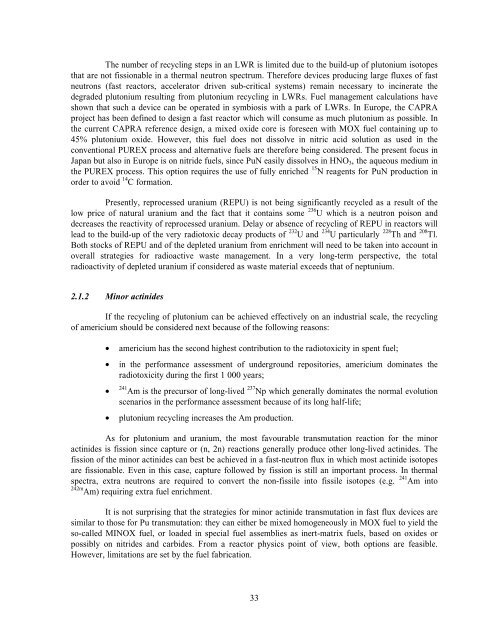COMPLETE DOCUMENT (1862 kb) - OECD Nuclear Energy Agency
COMPLETE DOCUMENT (1862 kb) - OECD Nuclear Energy Agency
COMPLETE DOCUMENT (1862 kb) - OECD Nuclear Energy Agency
You also want an ePaper? Increase the reach of your titles
YUMPU automatically turns print PDFs into web optimized ePapers that Google loves.
The number of recycling steps in an LWR is limited due to the build-up of plutonium isotopes<br />
that are not fissionable in a thermal neutron spectrum. Therefore devices producing large fluxes of fast<br />
neutrons (fast reactors, accelerator driven sub-critical systems) remain necessary to incinerate the<br />
degraded plutonium resulting from plutonium recycling in LWRs. Fuel management calculations have<br />
shown that such a device can be operated in symbiosis with a park of LWRs. In Europe, the CAPRA<br />
project has been defined to design a fast reactor which will consume as much plutonium as possible. In<br />
the current CAPRA reference design, a mixed oxide core is foreseen with MOX fuel containing up to<br />
45% plutonium oxide. However, this fuel does not dissolve in nitric acid solution as used in the<br />
conventional PUREX process and alternative fuels are therefore being considered. The present focus in<br />
Japan but also in Europe is on nitride fuels, since PuN easily dissolves in HNO 3 , the aqueous medium in<br />
the PUREX process. This option requires the use of fully enriched 15 N reagents for PuN production in<br />
order to avoid 14 C formation.<br />
Presently, reprocessed uranium (REPU) is not being significantly recycled as a result of the<br />
low price of natural uranium and the fact that it contains some 236 U which is a neutron poison and<br />
decreases the reactivity of reprocessed uranium. Delay or absence of recycling of REPU in reactors will<br />
lead to the build-up of the very radiotoxic decay products of 232 U and 234 U particularly 228 Th and 208 Tl.<br />
Both stocks of REPU and of the depleted uranium from enrichment will need to be taken into account in<br />
overall strategies for radioactive waste management. In a very long-term perspective, the total<br />
radioactivity of depleted uranium if considered as waste material exceeds that of neptunium.<br />
2.1.2 Minor actinides<br />
If the recycling of plutonium can be achieved effectively on an industrial scale, the recycling<br />
of americium should be considered next because of the following reasons:<br />
• americium has the second highest contribution to the radiotoxicity in spent fuel;<br />
• in the performance assessment of underground repositories, americium dominates the<br />
radiotoxicity during the first 1 000 years;<br />
• 241 Am is the precursor of long-lived 237 Np which generally dominates the normal evolution<br />
scenarios in the performance assessment because of its long half-life;<br />
• plutonium recycling increases the Am production.<br />
As for plutonium and uranium, the most favourable transmutation reaction for the minor<br />
actinides is fission since capture or (n, 2n) reactions generally produce other long-lived actinides. The<br />
fission of the minor actinides can best be achieved in a fast-neutron flux in which most actinide isotopes<br />
are fissionable. Even in this case, capture followed by fission is still an important process. In thermal<br />
spectra, extra neutrons are required to convert the non-fissile into fissile isotopes (e.g. 241 Am into<br />
242m Am) requiring extra fuel enrichment.<br />
It is not surprising that the strategies for minor actinide transmutation in fast flux devices are<br />
similar to those for Pu transmutation: they can either be mixed homogeneously in MOX fuel to yield the<br />
so-called MINOX fuel, or loaded in special fuel assemblies as inert-matrix fuels, based on oxides or<br />
possibly on nitrides and carbides. From a reactor physics point of view, both options are feasible.<br />
However, limitations are set by the fuel fabrication.<br />
33
















